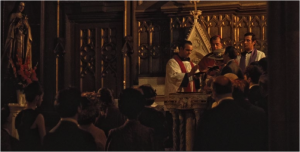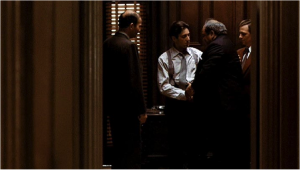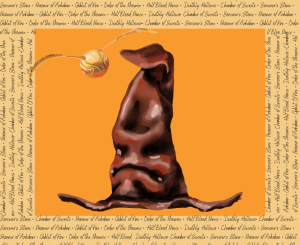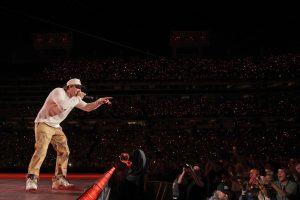Francis Ford Coppola’s The Godfather (1972) depicts the bloody power struggles within the Italian mafia in 1940s New York. When the revered yet aging Vito Corleone (Marlon Brando) is gunned down, his youngest son Michael (Al Pacino) comes to reluctantly take his father’s place as the ‘godfather,’ that is, the head of the powerful gang. Like any good classic film, The Godfather has lodged itself in the backdrop of my memory, but not so much for its plot or its phenomenal acting, but for the shadowy lighting, the suits, the unexpected bursts of blood—all of which exude an air of dark glamor. However, there’s more to the film than a gloss of sophistication; otherwise, it wouldn’t have become the iconic work that it is today. Indeed, the film triumphs by virtue of its powerful subtleties; each scene contains minute details that, like the interweaved strands of a fabric, invisibly contribute to the pleasing whole.
Before teasing out the individual strands, one must get an idea of the fabric in its entirety. One of the main tropes of The Godfather is Michael Corleone’s development from a pure, low-key Dartmouth student just released from the Marines, to a ruthless Don. However, rather than being transformed by external factors, Michael appears to have had the brutality and cunning in him all along, albeit in a dormant side of himself. As the movie progresses, this latent side slowly amplifies and unfurls, until he becomes hardly recognizable.
 Source: Alfan Productions and Paramount Pictures
Source: Alfan Productions and Paramount Pictures
Now for the strands. The Godfather is brilliant in part because it manages to encapsulate Michael’s entire transformation in a two-minute scene. Early on the film, Clemenza (Richard Castellano), a member of Vito’s gang, gives Michael a gun for his first murder. The scene opens with a zoomed-in shot of the gun. “Cold as they come.” The seconds in which Michael adjusts his fingers on the gun, as if feeling out the stony weapon, feel slow and oddly tense. “What’s the matter, the trigger too tight?” Suddenly, an earsplitting gunshot cuts through the air. Any doubts during the tense, uncertain seconds before the shot are forgotten. Michael raises his eyebrows but is otherwise unfazed. In fact, he lifts the gun to shoot again, but Clemenza says quickly, “All right, you shot ‘em both. Now what do you do?” Michael glances at him before responding calmly, “Sit down, finish my dinner.”
The scene’s subtleties encapsulate one entire plotline of the film. Indeed, its small actions and implications are Michael’s transformation in a nutshell. But there is yet another intriguing detail. In the scenes background, there is a black-and-white print of a Catholic saint taped to the wall. During the first half of the scene, the saint is fully visible, and feels like a watchful, silent judge to the men’s actions. During the second half, however, after the camera angle shifts and Michael moves, the print becomes partially concealed by Michael’s head, almost as if Michael has merged with the saint.
 Source: The Art of a Film
Source: The Art of a Film
This saint subtly foreshadows the baptism scene, one of the most famous and timeless scenes of the film. In it, Michael stands as godfather during the baptism of his sister’s baby son. Simultaneously, the gang members, who now work under Michael, kill six powerful men in other parts of the country. The scene is clearly ironic in that, under Michael’s orders, the men spill blood just as he vows to renounce Satan and his works. However, there is another, subtler irony. The priest’s hands, which handle the baby, frequently cut to the murderers’ hands, which handle pistols. This parallel underscores Michael’s double role as the godfather. He is the intimate second father to the children of his family, the revered mentor and benefactor of countless men. However, he is also the leader of a bloody gang, a dangerous figure who spills blood without remorse. And as the baptism (as well as the saint print) implies, Michael is a subverted reflection of God himself: a god-father. He himself never commits murder, simply commands it. He sees all, understands all, and coordinates his men accordingly. In fact, the murders during the baptism are an act of vengeance, so the deaths are, in a corrupt sense, justice served. At the same time, one can’t help but consider—as the hymns blast, the baby cries, Michael’s dissipated eyes pierce somewhere beyond the camera—how far he’s come; he has unknowingly embarked on a path which he can now never retrace.
Займы онлайн на любые нужды по паспорту без справок и поручителей. Деньги выдаются наличными, переводятся на карту или банковский счет.
 Source: Meedosite
Source: Meedosite













